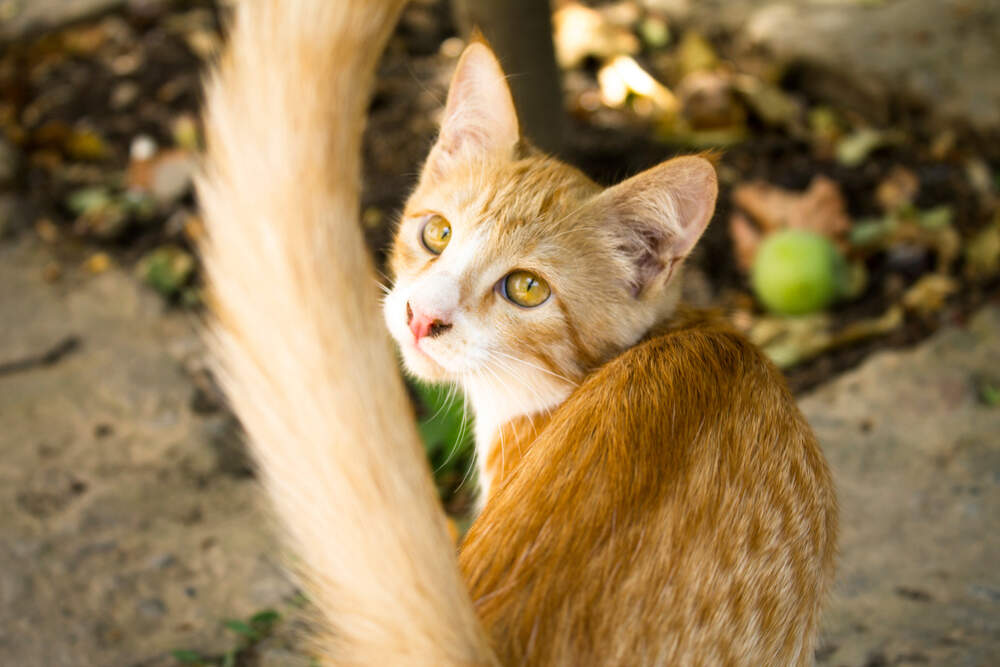Why Do Cats Wag Their Tails?
Why do cats wag their tails? You might be surprised to learn that tail wagging is very different for cats than for dogs. Cats may flick their tails while walking, thump their tails while lying down or hold their tails up high when they see you—cats have a unique body language all their own. But if you do a little research and pay close attention to your cat, you can soon learn exactly what your cat is trying to say each time he wags his tail.
Cats Sometimes Wag or Thump Their Tails While Lying Down
Why do they wag their tails while lying down? It may seem especially strange when cats wag or thump their tails while relaxing. Often, it means she's beginning to feel a little overstimulated. If she's lying down or even sitting calmly, she may swish her tail a little after you've been petting her. This wagging of her tail can mean she's feeling a little annoyed or overstimulated and needs you to give her some space.
Sometimes it can also mean she has a lot of energy, and even though she was lying down calmly, now she's ready to play. This would be a good time to withdraw your hand, stop petting her and grab a cat toy. Otherwise, you might find your hand soon becomes the toy, and you'll end up with a few scratches from an overly exuberant kitty.
Cats May Even Wag Their Tails When Sleeping
Why do cats wag their tails while sleeping? Sometimes your cat might be in a deep sleep and twitches his tail while dreaming. Or, just like your muscles might twitch a little while you're asleep, his tail might twitch too.
But other times, he might not be sleeping as deeply as you think.1 If you call his name and he doesn't come to you but slowly begins to wag or swish his tail, then he's likely awake and trying to decide if he wants to get up. His gentle tail swish lets you know he hears you and knows you're there.
Cats May Wag Their Tails When Hunting
Cats also wag their tails when they're hunting. Sometimes this looks more like an energetic swish or even a persistent thump. This often happens when she's watching birds out the window and becomes very focused on her prey.2 She may also make "clicking" sounds as she watches the birds, and you might even see her fur ripple a little. Your cat might swish her tail in a similar manner if she's hunting a bug in your house and about to channel her inner tiger as she dashes to her prize. The tail can help your cat with balance and agility, so swishing it while hunting helps her stay ready to pounce.
Cats May Display a Puffy Tail When Threatened
When a cat feels threatened or is unexpectedly startled, he will puff up his tail until it's twice its normal width or even larger. He may also puff up the rest of his fur in an attempt to make himself look bigger and more threatening. Often, he'll do this when he sees a strange cat and is getting ready for a fight. But he also might do this when he hears a sound that startles him, and he's not sure what's happening.
Cats Wag Their Tails When They're Happy and Confident
Dogs are known for wagging their tails when they're happy, but do cats ever wag their tails for the same reason? Although cats do not have the same enthusiastically happy tail wag dogs are known for, they certainly can wag their tails when they're happy.3
When your cat is feeling happy and confident, she'll walk around your home with her tail held high, pointing straight to the sky. Sometimes she'll also slightly curve the tip of her tail and even twitch or wag it softly. This isn't the same exuberant tail wag dogs use, but it's a subtle way to let you know she's happy and content.
Cats might also wag their tail more energetically when they're playing, swishing their tails from side to side. You might notice your cat doing this when she's chasing a feather wand you're holding or when two cats are "play fighting." This is a good way to tell if two cats are play fighting or being serious. If your cat feels threatened, she's more likely to puff up her tail. When she's just playing, she's more likely to swish and wag it.
Use Comfort Zone Products to Calm a Nervous Cat
If your cat feels stressed, Comfort Zone products can help your cat's e-meow-tional health. The Comfort Zone Cat Calming Diffuser with Opticalm Diffuser mimics your cat's natural pheromones, signaling in his own language that everything is safe and secure. The diffuser helps reduce stress, allowing your cat to feel calmer and more relaxed.
If you have more than one cat in your home, try the Comfort Zone Multi-Cat Diffuser with Opticalm Diffuser. If your cat's on the go a lot, the Comfort Zone Calming Pheromone Collar will allow the calming effect to be with him wherever he goes, whether he's exploring your home or venturing outside.
Remember, every cat is an individual. This is a general guideline of what different types of tail wagging can mean, but each cat also has a language unique to him. So spend a lot of time with your kitty, studying his different moods and how his tail may reflect what he's feeling. Over time, you'll decode the unique messages that come with every swish and wag of his tail.
1. Bailey, Angie. "Cat Tail Wagging: The Meaning of Your Cat's Different Tail Wags." Catster, 14 April 2021, https://www.catster.com/cat-behavior/cat-tail-wagging-the-meaning-of-different-cat-tail-wags.
2. Kolitz, Daniel. "Why Do Cats Wag Their Tails?" Gizmodo, 7 May 2018, https://gizmodo.com/why-do-cats-wag-their-tails-1825820565.
3. Moshman, Rachael. "Why Do Cats Wag Their Tails?" Care.com, 20 June 2017, https://www.care.com/c/stories/6422/why-do-cats-wag-their-tails/.

